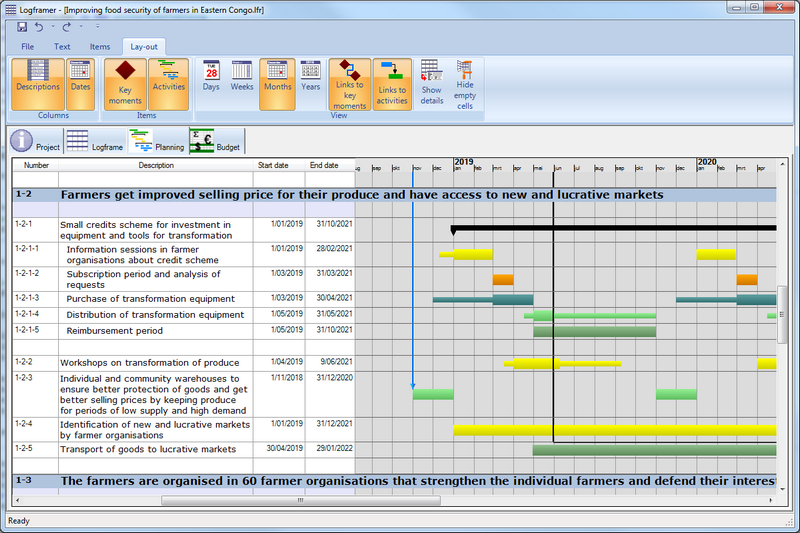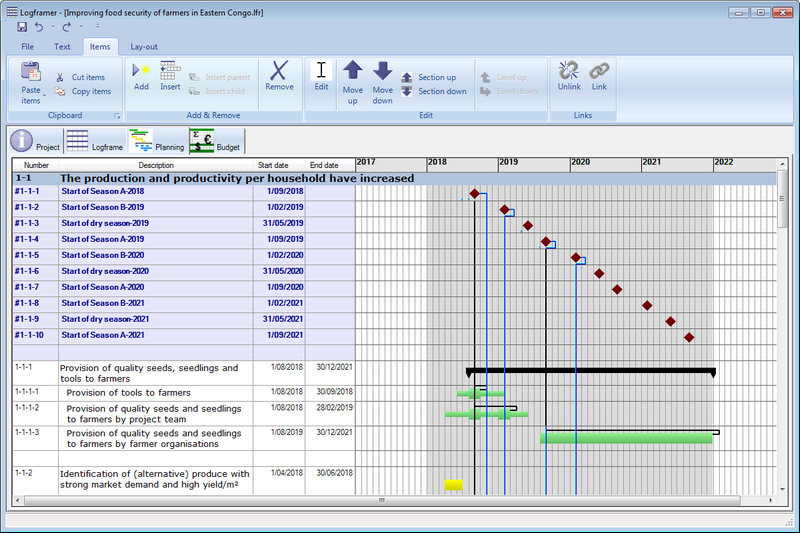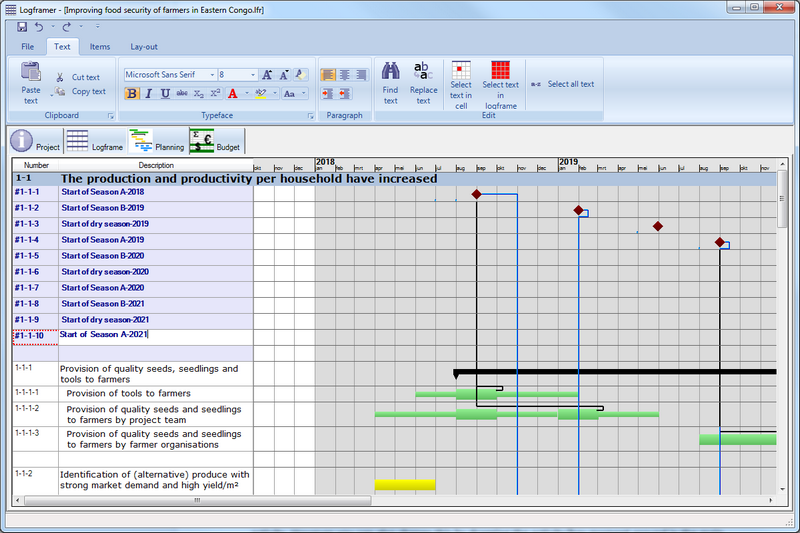Working with the planning
To design the planning of your project, select the Planning tab.
The Planning window allows you to plan the project's key moments, processes and activities. Using the Details pane you can also specify additional information. This in turn will allow you to design specific tools:
|
Main window |
Details pane |
Tools |
|
Key moments |
Relation of key moment to other key moments or activities (1) |
|
|
Processes |
Who organises and where (1) |
|
|
|
Child activities (1) |
|
|
Activities & sub-activities |
Relation of activity to other key moments or activities (1) |
|
|
|
Duration of activity (1) |
|
|
|
Who organises and where (1) |
|
|
|
Preparation and follow-up periods (1) |
|
|
|
Repeating activities (1) |
|
(1) You can also do this in the Logframe window. In the Details pane of the logframe you can modify dates, durations and so on, but in the Planning window you have drag-and-drop functionality.

Planning items
The planning window allows you to plan the different activities and key moments (milestones) of your project. It contains the following items:
- Key moments such as deadlines, milestones, external events, etc.
- Processes, which consist of several activities
- Activities, which can exist on their own or as part of a larger process. If you add sub-activities to a parent activity, it becomes a process.
Activities, processes and key moments are grouped per output of your logical framework. Key moments are always ordered by date.

Parent-child relations
Planning items are linked to each other in two ways:
- Outputs and key moments are vertically linked to each other (vertical logic): each output can have several key moments
- Outputs and activities are vertically linked to each other (vertical logic): each output can have several activities
- Each activity (process) can have several sub-activities (and so on)
When you move items around, Logframer will make sure the vertical logic remains intact. This means for instance that when you drag output 2 before output 1, that the key moments and activities of output 2 will also be placed before those of output 1.
Adding items and working with text
For each output, there are two sections in the main planning window. Directly below the output you can enter key moments in the blue section. If this blue section is not visible, go to the Lay-out toolbar and in the Items section click on the Key moments button.
Below the blue key items section in the planning is the activities section (in white). To add an activity, simply start typing in an empty cell. If the white activities section is not visible, go to the Lay-out toolbar and in the Items section click on the Activities button.

You can edit the text of the activities and processes like you would in any word processor using the Text ribbon tab. You can change the typeface or size, make text bold, underlined... and align the text to the left, right or centre.
You can't change the typeface etc. of the key moments.

Moving items around
You can move a key moment to another output. But you can't change the order of the key moments of a certain output because they are ordered according to date.
You can change the order of the activities of an output and drag activities from one output to the other.
To select a single item, click on it with the left mouse button. To select more than one item, press the left mouse button and drag. The red selection rectangle will expand to include other cells, but you can only select cells within a single section.
To move items, press the right mouse button within your selection (red selection rectangle) and drag it to the place where you want to insert the items. A green indicator line will appear and show the current location. When you come close to the top or bottom border of the logframe, it will scroll up or down. Release the right mouse button to insert the items you selected.
Another way to move items is to use the Move Up and Move Down buttons in the Lay-out ribbon tab (only enabled for activities, not for key moments). You can also move the item one section up or down (from one output to the other).

Copying and pasting planning items
You can cut, copy and paste items in three different ways. First select the items you want to copy paste (see ‘Moving items around’).
- Use the Cut, Copy and Paste buttons of the Items ribbon tab.
- Press Ctrl+X to cut; Ctrl+C to copy and Ctrl+V to paste
- Right click into the red selection rectangle and move the green indicator line to where you want to copy the item(s) (see ‘Moving items around’). But this time hold the Ctrl button when you release the right mouse button. This will copy the selected item(s) instead of cutting and pasting them.

Dragging to change start, end and duration of activities and key moments
You can use the Details pane to specify the date of a key moment or the start date and duration of an activity. However you can also change this by dragging the activity/key moment around in the main window.
Key moments:
- Click and hold the key moment with the left mouse button. Drag it in the direction of the date you want to place it. You will see a date appearing next to the key moments symbol (the red diamond shape), allowing you to release it exactly on the right date.
- Notice that the key moments are listed according to date. So if your key moment comes before or after other key moments, it will change its place in the list (going up or down in the list).

Activities:
- To change the starting date of the activity: click and hold the left side of the activity bar and then drag it in the direction of the date you want to place it. You will see a date appearing next to the activity bar, allowing you to release it exactly on the right date. This operation will not change the duration of the activity

- To change the end date of the activity: click and hold the right side of the activity bar and then drag it in the direction of the date you want to place it. You will see a date appearing next to the activity bar, allowing you to release it exactly on the right date. This operation will change the duration of the activity.
- To move the activity without changing the duration: click and hold somewhere inside the activity bar and then drag it in the direction of the date you want to place it. You will see two dates appearing next to start and end of the activity bar, allowing you to release it exactly on the right date. This operation will not change the duration of the activity.
- A shorter/longer preparation period: click and hold the left side of the thin preparation bar before the activity and then drag it in the direction of the date you want to place it. You will see a date appearing next to the preparation bar, allowing you to release it exactly on the right date. This operation will change the duration of the preparation period but will not change the start date or duration of the activity.

- A shorter/longer follow-up period: click and hold the right side of the thin follow-up bar on the right side of the activity and then drag it in the direction of the date you want to place it. You will see a date appearing next to the follow-up bar, allowing you to release it exactly on the right date. This operation will change the duration of the follow-up period but will not change the start date or duration of the activity.
Changing the lay-out of the planning
Using the Lay-out toolbar, you can hide certain columns; hide or show key moments and/or activities; select the level of detail of the Gantt chart; hide or show links between key moments and activities; and show or hide the Details pane.

The Lay-out toolbar has the following ribbon panels and buttons:
- Columns ribbon panel: hide or show the Dates column. The Descriptions column will always remain visible.
- Items ribbon panel: hide or show the key moments and/or the activities.
- View ribbon panel:
- Set the level of detail of the Gantt chart to days, weeks, months or years
- Show or hide the links between key moments and/or activities
- Hide or show the Details pane at the bottom of the screen
- Hide empty cells: click this button to hide the empty cells at the bottom of each group of items. This will make the view of the planning more compact. You can still insert or add items using the Items ribbon.